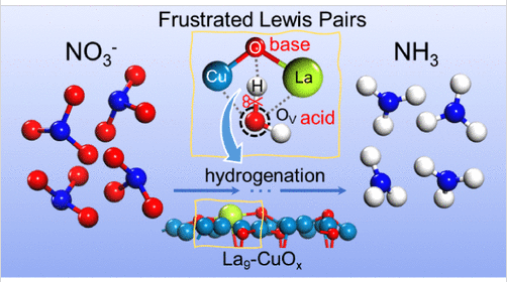
近日,香港城市大学支春义团队研究了用于安培级合成氨和高功率密度硝酸锌电池的人工受阻刘易斯对。相关论文于2025年10月29日发表在《美国化学会志》上。
铜基电催化剂在硝酸电化学还原反应(NO3RR)中表现出优异的还原动力学,抑制了竞争的析氢反应,使NO3RR成为传统Haber-Bosch工艺生产NH3的替代品。然而,NH3生产中的NO3RR涉及一个9质子8电子的过程,其性能受到质子生成能力差的限制。
研究组在铜基催化剂中引入了由Cu-O-La基序中的Lewis酸性位点Ov和Lewis碱性位点O形成的FLPs [Cu-O-La - Ov] (v表示空位),并将FLPs (v表示空位)作为活性位点。这些活性位点促进了H2O的解离,为NO3RR的氢化提供了充足的质子。La9-CuOx催化剂的NH3生成过电位仅为290 mV,
在- 0.4 V条件下,NH3电流密度为1.76 A cm-2, NH3产率为139.5 mg h-1 cm-2,法拉第效率为98.9%。由于La9-CuOx具有优异的NO3RR性能,La9-CuOx基Zn-NO3-电池的功率密度达到80.6 mW cm-2, NH3产率达到21.4 mg h-1 cm-2。本研究阐明了FLPs对NO3RR的促进作用,实现了同时实现发电和NH3生产的高效Zn-NO3-电池。
附:英文原文
Title: Artificial Frustrated Lewis Pairs for Ampere-Level Ammonia Synthesis and High-Power-Density Zinc-Nitrate Battery
Author: Shaoce Zhang, Dong Chen, Rong Zhang, Xinru Yang, Xintao Ma, Chuan Li, Huilin Cui, Zhiquan Wei, Yiqiao Wang, Peng Chen, Xun Guo, Shixun Wang, Johnny C. Ho, Ying Guo, Chunyi Zhi
Issue&Volume: October 29, 2025
Abstract: Cu-based electrocatalysts exhibit superior reduction kinetics in the electrochemical nitrate reduction reaction (NO3RR) and suppress competing hydrogen evolution reaction, making NO3RR an alternative to the traditional Haber–Bosch process in NH3 production. However, the NO3RR in NH3 production involves a nine-proton and eight-electron process, and its performance is constrained by the poor capacity to generate protons. In this study, frustrated Lewis pairs (FLPs) were introduced into Cu-based catalysts to create La-doped Cu2O, in which the FLPs [Cu–O–La–Ov] (where v denotes vacancy) formed by the Lewis acidic sites Ov and Lewis basic sites O in the Cu–O–La motif served as active sites. These active sites facilitated H2O dissociation, providing ample protons for the NO3RR hydrogenation. The La9–CuOx catalyst exhibited an ultralow NH3 production overpotential of only 290 mV, achieving an NH3 current density of 1.76 A cm–2 at 0.4 V vs the reversible hydrogen electrode, with an NH3 yield rate of 139.5 mg h–1 cm–2 and Faradaic efficiency of 98.9%. Due to the superior NO3RR performance of La9–CuOx, a La9–CuOx-based Zn-NO3– battery achieved a remarkable power density of 80.6 mW cm–2, with an NH3 yield rate of 21.4 mg h–1 cm–2. This study clarifies the role of FLPs in facilitating the NO3RR and achieves an efficient Zn-NO3– battery to accomplish electricity generation and NH3 production simultaneously.
DOI: 10.1021/jacs.5c11084
Source: https://pubs.acs.org/doi/abs/10.1021/jacs.5c11084
JACS:《美国化学会志》,创刊于1879年。隶属于美国化学会,最新IF:16.383
官方网址:https://pubs.acs.org/journal/jacsat
投稿链接:https://acsparagonplus.acs.org/psweb/loginForm?code=1000
